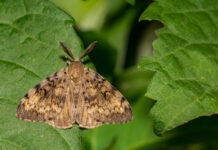North Carolina Is Using Canines To Deter The Spread Of This Invasive Pest Affecting Plants & Trees

What’s better than a good dog story? One that’s also about eliminating invasive pests, like spotted lanternfly (SLF)! Detector dogs—trained by USDA’s Plant Protection and Quarantine (PPQ) program— represent some of the recent successes of the Agricultural Detector Canines strategic initiative. Its goal is to expand the use of detector dogs to enhance domestic pest surveys, detect pests early, and facilitate the trade of U.S. agricultural products.
The North Carolina Department of Agriculture and Consumer Services (NCDA&CS) took note of the program when SLF was detected just north of their State in Virginia. “The State wanted to use canines to help keep the pest out, so NCDA&CS sought funds and assistance from PPQ through a cooperative agreement for more than $200,000,” said National Operations Manager Betsy Randall-Schadel. “Things moved pretty quickly because NCDA&CS made the commitment to fund the salaries of the canine handlers.”
Normally, detector dogs and their handlers attend an eight-week course at PPQ’s National Detector Dog Training Center (NDDTC) in Newnan, GA, before transitioning to the field. But the SLF project was different.
“North of the North Carolina border, Virginia has a few SLF infestations, including one in Winchester, and that was a fantastic opportunity for training in the environment,” said NDDTC Training Specialist David Jones, who trained the dogs and their handlers and helped deploy them in the field. “Instead of hosting the entire eight-week course at the center, we traveled to Winchester for the last four weeks to train the dogs in the field where they could find plenty of fresh SLF egg masses.”
That’s just what the dogs did. They found egg masses around known SLF pathways associated with railroads and trucking. While SLF adults can hitch a ride, the potential movement of egg masses on trains or trucks can cause SLF to spread long distances. Prime survey spots for the canines were next to rail lines or tractor trailer parking areas.
“The dogs got a little bit confused in Virginia at first when they transitioned from the center, where they used deactivated egg masses, which were frozen to minus 80˚ F and then thawed,” Jones said. “In Virginia, they were detecting fresh egg masses. We had to help the dogs. At first, they needed to be on top of an egg mass to smell it, but soon they were detecting the scent from across a parking lot and pulling us to the target.”

Jones took the NCDA&CS canine handlers and their dogs to the field in North Carolina for “installation training,” which means ensuring a smooth and effective deployment to real-world conditions. Jackie Fredieu and her Labrador retriever Kita worked in the Raleigh area, and Chad Taylor and his Lab Neeko worked in Boone.
“We were lucky because the weather was mild at that time in both Raleigh and Boone,” Jones said. “The dogs’ missions were very different in each location. In Raleigh, Jackie and Kita focused on nursery stock. In Boone, which is a beautiful city in the Blue Ridge Mountains, Chad and Neeko surveyed vineyards and Christmas tree farms. Fortunately, neither dog has found SLF to date [in these locations].”

For the full story, visit Plant Protection Today.











![[VIDEO] Dickies®: Discover Workwear That’s Anything But Uniform](https://turfmagazine.com/wp-content/uploads/2023/06/1647663814-4b1a2a7742790a9b1e97a3b963477850192e1d6a9dfba9b07214a77bae25d6e3-d-218x150.jpg)































![[VIDEO] Dickies®: Discover Workwear That’s Anything But Uniform](https://turfmagazine.com/wp-content/uploads/2023/06/1647663814-4b1a2a7742790a9b1e97a3b963477850192e1d6a9dfba9b07214a77bae25d6e3-d-324x160.jpg)